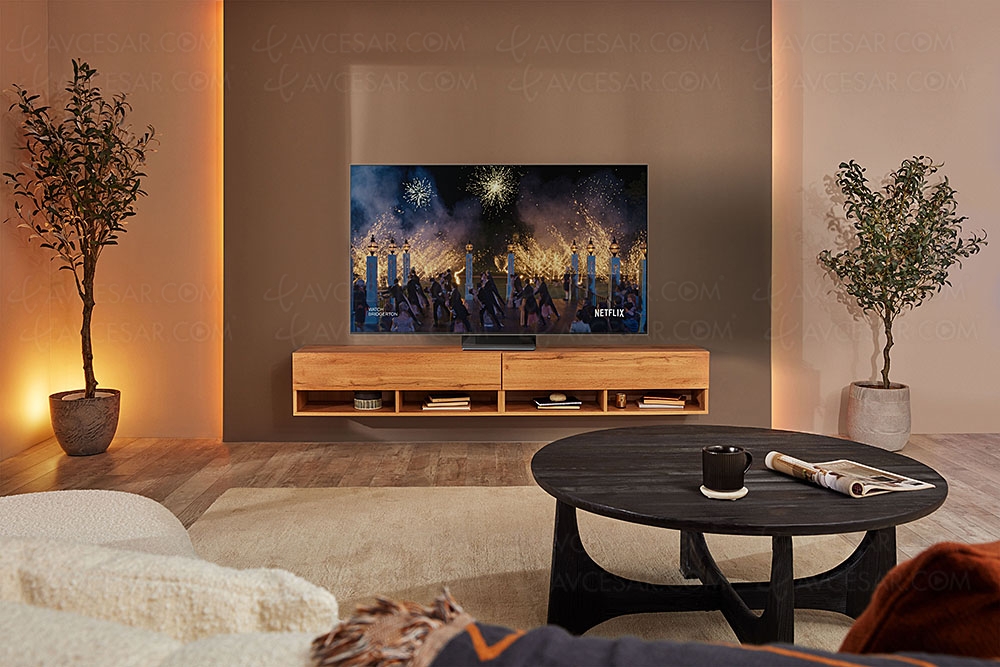QD Technology, for Quantum Dot Technology by Samsung, here is the new logo that fans of exceptional images will now hunt down. Whether it's brightness, contrast, management of dark shades and deep blacks, or even richness of colors, Quantum Dots, inorganic nanocrystals with specific quantum behavior, are today profoundly transforming OLED screens. , after revolutionizing LED TVs. To the point of convincing Samsung to reconsider its decision to abandon Oled TVs in 2016, and to market the Oled S95B TV series within its 2022 range.
The manufacturer Samsung has been interested in research around Quantum Dots for many years. Materials with remarkable characteristics whose quantum behavior makes it possible to convert light of a given wavelength into light of a different wavelength (see our dossier With Quantum Dots, Samsung is revolutionizing Ultra HD). Explanations.
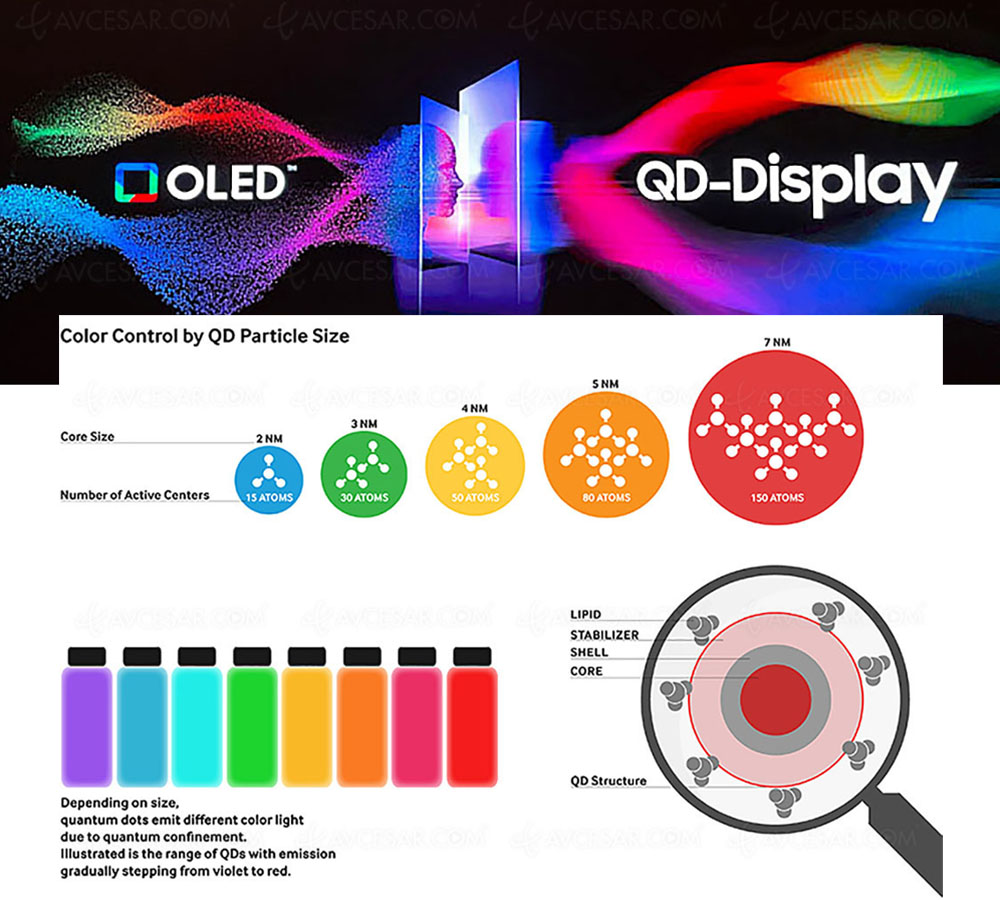
The new quest for the three RGB colors via Quantum Dots Quantum Dots nanocrystals are therefore able to change the color of a light source actively (and not passively as a simple color filter would). The avowed aim of such an operation, when it comes to the screen, is obviously to carry out conversions adapted to the restitution of green, red and blue (RGB) from a light source equipped with any “a priori†wavelength. In order to recreate, with the addition of these three primary colors, the white light necessary for all diffusers to display images on the screen. In practice, for Samsung QLED TVs it is a question of converting the light blue LEDs, and for Samsung Oled TVs blue organic diodes. As you understand by reading these lines, the blue color of these QLED/Oled TVs is already in order, so no quantum conversion is necessary for the latter. On the other hand, the Quantum Dots are at work to generate green and red from this blue light (see illustrations below).
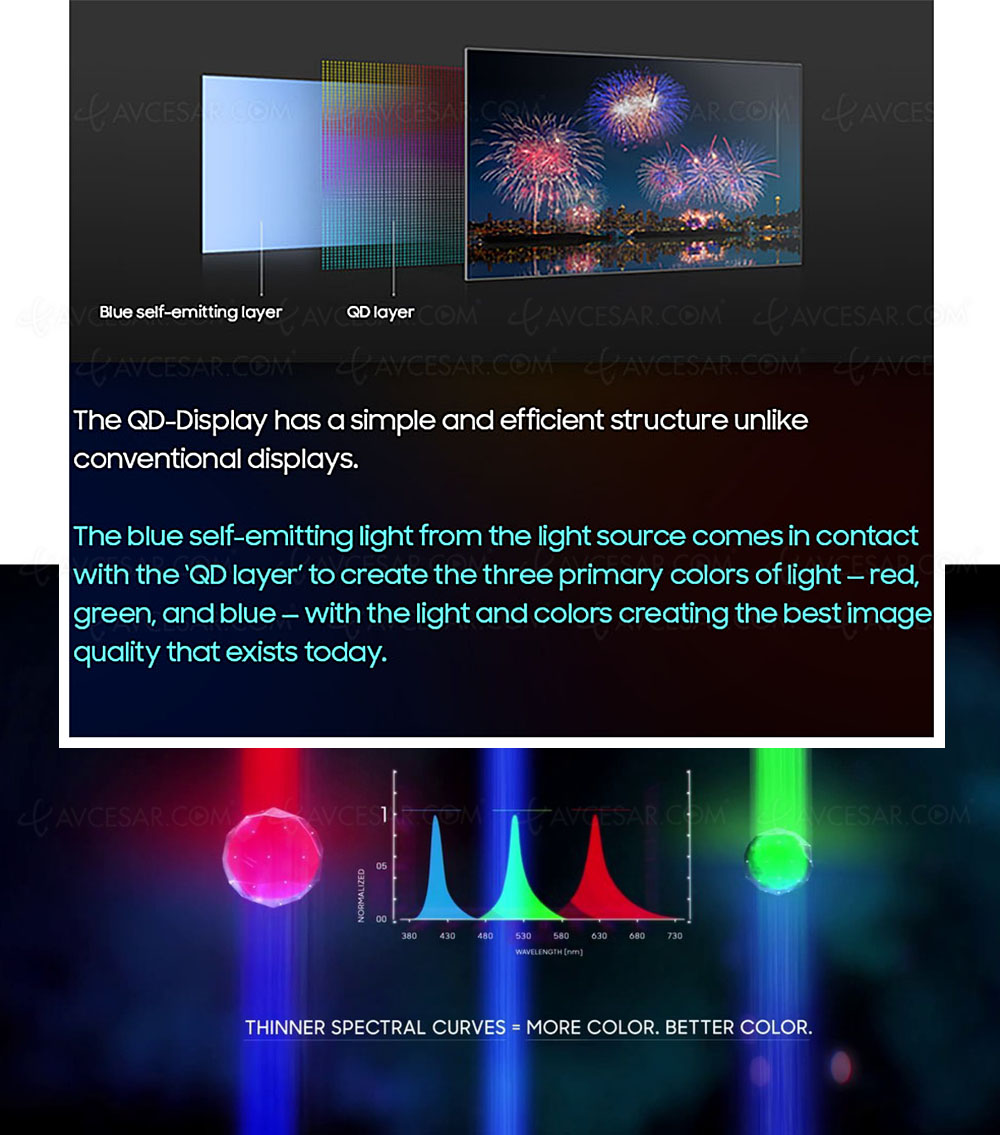
The classic quest for the three RGB colors via color filters color Until recently, obtaining the three fundamental colors essential to the restitution of an image was done using filters. In fact, each pixel of the image receiving light from a backlight based on white LEDs for LCD TVs, or generating its own white light in the case of White Oled technology, consisted of three "sub-pixels », each associated with a red, green or blue filter. A passive "subtractive" system called Bottom Emission (light coming from the back of the TV panel before being transformed to reach the viewer's eye) causing a strong loss of brightness (see illustration below, diagram on the left) . With this method, to generate red light, the red filter eliminates the light rays of white light not corresponding to red. Similarly, the blue filter or the green filter “throws away†radiation that does not correspond to its hue. A real waste in terms of energy which makes it difficult to produce screens with high luminosity, especially, as we will see later, in OLED technology.
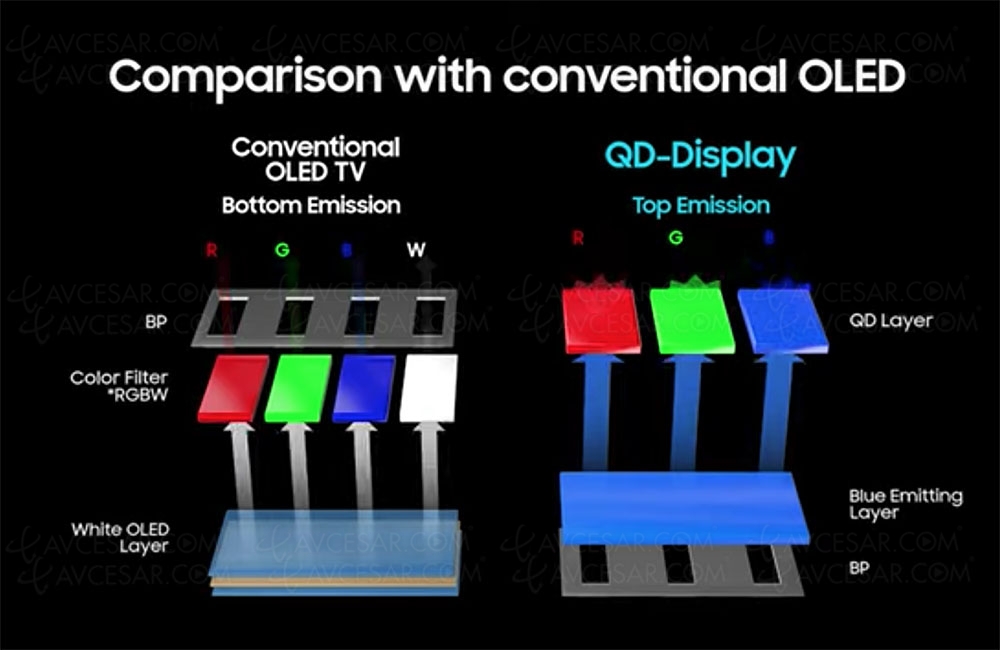
Quantum Dots, how does it work!! !!! Quantum Dots are much smarter. These nanocrystals (size less than 100 nm), with astonishing quantum behavior, deliver light at the desired wavelength (red or green here, blue not needing conversion as already mentioned) in a totally different way via the Top Emission principle (color conversion operated on the front of the panel). Instead of eliminating unwanted wavelengths, they convert blue light giving it a wavelength corresponding to the expected color (see illustration above diagram on the right and below for more details). This wavelength, therefore its color, is linked to the size of the quantum dots that make up each crystal. Proof by example…
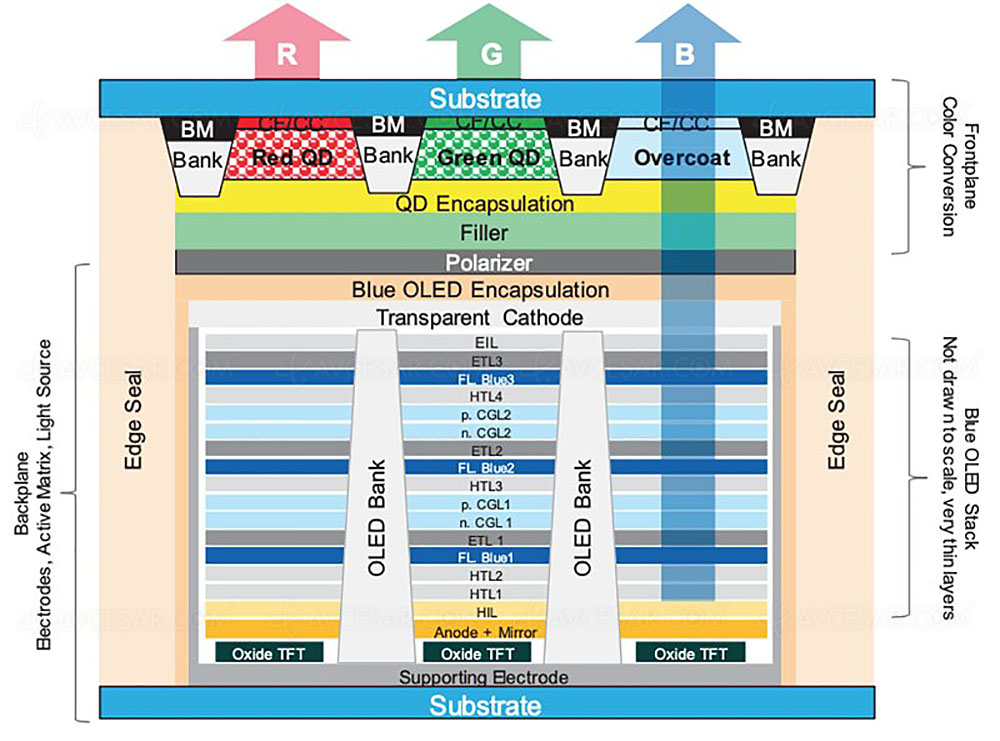
Even if the link is only distant, we can compare this behavior to that of certain fluorescent dyes illuminated with “black lightâ€. At one time, in discotheques, the massive use of black light (in fact soft ultraviolet light) made it possible to make certain clothes in bright colors luminescent. Nowadays, some bright yellow highlighters exhibit the same behavior. Even if the quantum phenomena brought into play on the Quantum Dots are infinitely more complex, the comparison remains possible. Their major advantage also lies in the fact that they adapt relatively easily to various screen technologies. After modifying the light source, they therefore replace conventional filters. In the jargon of the screen industry, we speak of QDCC layer for Quantum Dot Color Conversion (see illustration below).

On LED screens (therefore LCD), the Quantum Dots provide even more brightness to images. Thanks to their excellent wavelength conversion efficiency, they offer tremendous progress to LCD technology in terms of colorimetry, without forgetting the possibility for suitable TVs to display very high light peaks. All of this translates into a Color Volume without common measure with that of OLED TVs. In short, to sum up, we can say that Quantum Dots technology has allowed LCD technology to reinvent itself and develop new advantages. Especially if, since last year, it has been associated with a Mini LED backlighting system which allows it to compete in terms of depth of black with the White Oled process of Oled TVs.
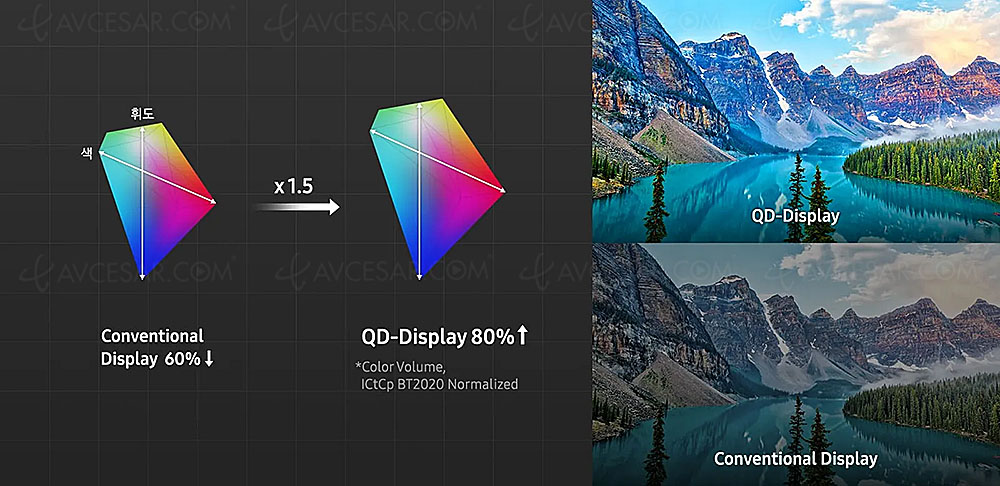
Quantum Dots and Oled technology It is now on Oled screens that the contribution of Quantum Dots is of new interest (see the complete test of the Samsung QE55S95B television by the editorial staff of AVCesar.com). Indeed, the manufacturing process of the OLED, based on the deposition in thin layers of different organic components, makes it difficult to obtain high luminosity. Let's not forget that this specificity had led Samsung to temporarily leave Oled technology aside in 2016 for problems mainly related to long-term reliability. As their name suggests, Oleds are based on organic compounds (the O in the acronym Oled stands for Organic), and having them work in extreme conditions to obtain satisfactory brightness is not without impact on their duration. of life. Samsung feared premature aging of the diodes or long-term marking phenomena. In short, fears reminiscent of those aroused by plasma panels. On the other hand, the remarkable behavior of OLED screens in managing the darkest shades and deep blacks remains undeniable.
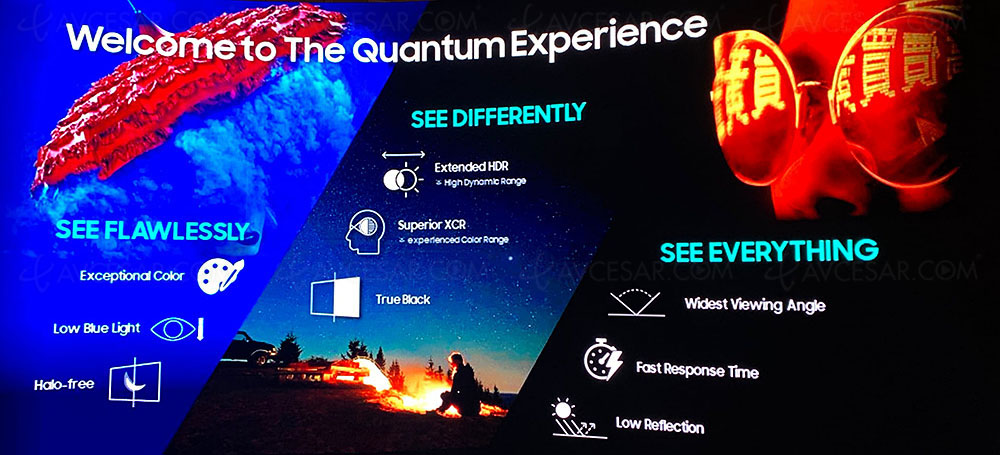
The appearance of Quantum Dots is therefore upsetting the situation. They make it possible to operate OLEDs with significantly improved efficiency (see below), in much better conditions, and thus to avoid their premature aging leading either to a loss of screen brightness, or even worse for the comfort of vision, the appearance of marking phenomena (Burn-In). An observation that led Samsung to revise its position vis-Ã -vis Oled technology and to market it again with the label Oled Powered by Quantum Dot Technology (also known as QD Oled or QD Display and already mentioned as such in our columns). Oled Powered by Quantum Dot Technology, exclusive assets The gain in luminosity offered by the Quantum Dot Technology sector for OLED screens is obvious with a luminous peak at 1,500 nits. But that's not their only advantage over traditional White Oled diffusers. These screens of course offer all the subtlety of managing the darkest shades and the extremely high contrast ratio specific to OLED technology (see photo on the right below). Furthermore, there is no halo effect linked to the management by zone of the backlighting as may still be the case with specific images on screens equipped with a Local Dimming device such as Mini LED.
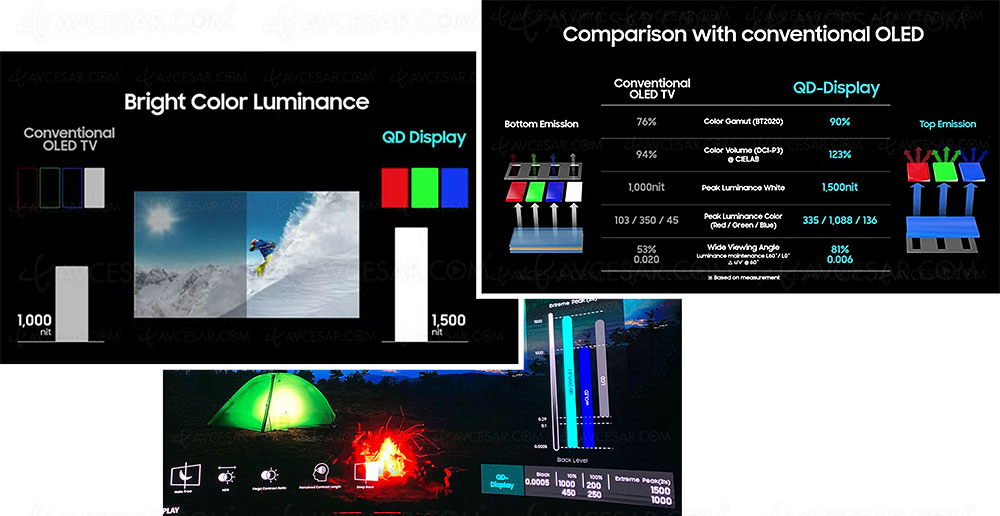
To go even further in managing dark shades, Samsung has equipped its QD Oled screens with an anti-reflection filter derived from that of its LED panels, guaranteeing excellent viewing comfort even in "normal" ambient light . Likewise, due to the absence of polarizing lenses (the light emitted by the Quantum Dots is not polarized), these screens benefit from a particularly wide viewing angle (see photos below). Another strong point inherited from the Oled sector: the speed of reaction. Indeed, on an LCD panel, liquid crystals have a relatively high reaction time, which tends to induce blurring effects on the fastest movements, even to constitute a handicap for gamers. Here, nothing of the sort. As the "active" part to form the image is based on OLEDs, the reaction time is almost nil. Another corollary of Quantum Dot Technology OLED technology, directly linked to its OLED ancestry: nothing happens. opposes the design of particularly thin screens since they do not require backlighting (see photos below). It even seems that Samsung Display, the screen manufacturer division of the Samsung group, is already developing flexible Quantum Dot Technology Oled panels to offer roll-up screen TVs in the future capable of hiding in a low cabinet when the device is not in use. is not used.
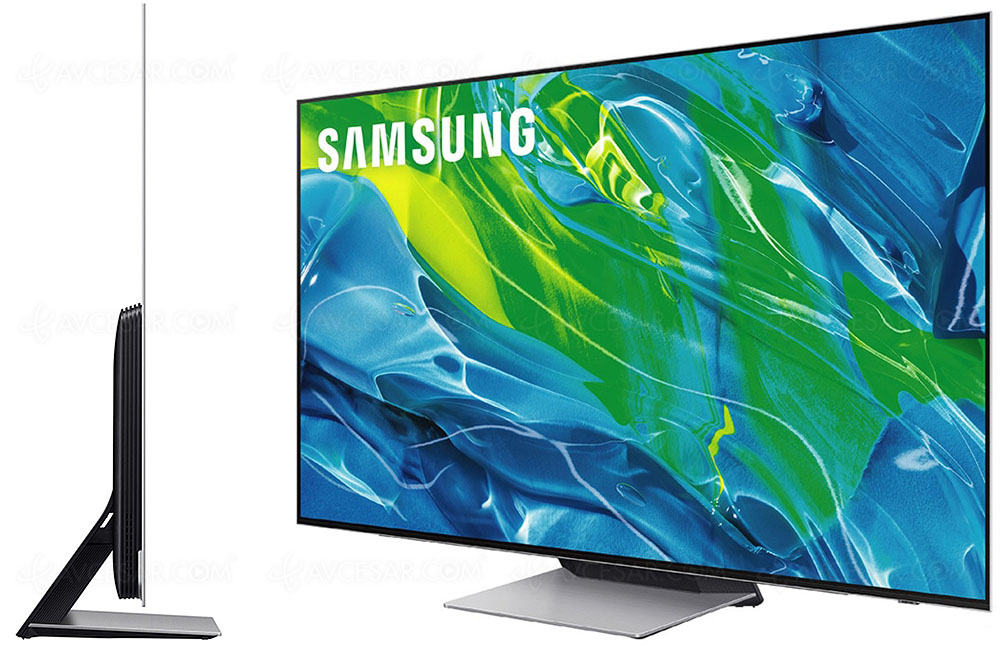
Quantum Dots or the queen colors Finally, Quantum Dots offer a wider color palette compared to passive filter systems. If traditional screens cover on average 76% of the Gamut Rec.2020, QD Oled manage to cover 90% (for respectively 94% and 131% of DCI-P3). Hence a feeling of more vivid colors, well saturated and at the same time more subtle in their respect for natural hues. As with QLED TVs, this is also explained by the ability of QD Oled TVs to display saturated colors even in the presence of a high light peak. Still this story of Color Volume…
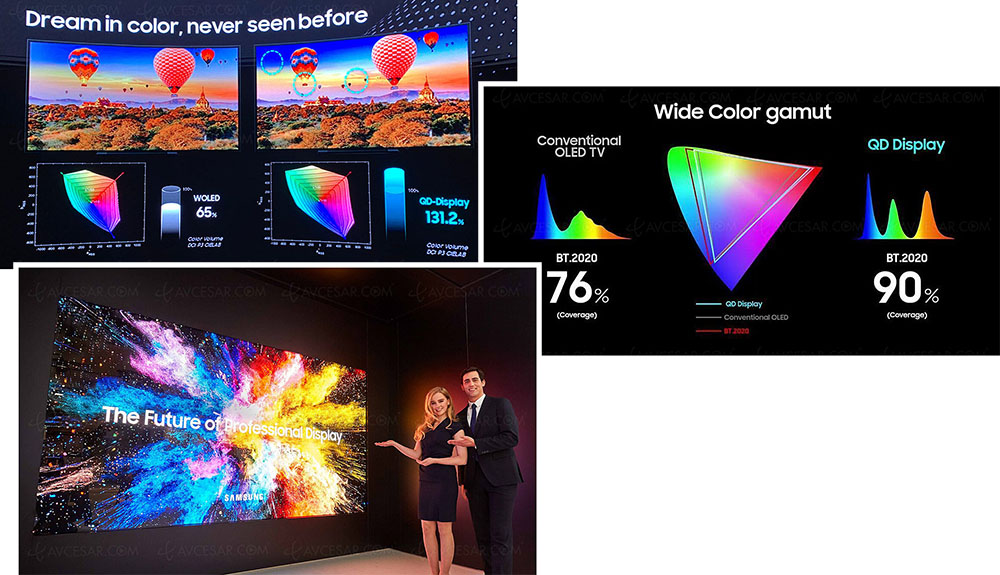
It is also, of course, directly linked to the additive structure of the RGB sub-pixels (Red, Green, Blue), their colors adding up to create all possible colors. The light peak is therefore constant on all the chromatic components of the pixel and not only on the white sub-pixel of the structure of the White Oled panels (WRVB). With the latter, the white pixel, which is increasingly used to obtain a high light peak, dilutes the other sub-pixels until they “burn†them. A phenomenon of fading of the colors particularly visible for example on certain images of the film 2001, a space odyssey. Quantum Dot Technology Oled gaming monitors Finally, note that if the Samsung group seems to primarily use its Quantum Dot Technology Oled panels for its production of televisions and computer monitors (see the Samsung Odyssey G8, in the photos below, which appeared at the IFA show in Berlin in early September) , the manufacturer also offers them as OEM (Original Equipment Manufacture). Thus, they already equip some Sony brand televisions (the A95K series). Similarly, the company Samsung Display, manufacturer of QD Oled panels, has already signed agreements with the computer equipment manufacturer Dell to equip some of its high-end monitors, more specifically on its Alienware gaming models (see second series of photos below).

0 This is an important element concerning QD Oled technology, the video game signal being considered the most difficult to manage for screens, with strong fluctuations in color, light and user/player interfaces with graphic elements often "stuck" to the same place in the image (level of life, equipment, map, etc.).

1 With this kind of agreement, Samsung illustrates its confidence in its QD Oled technology, in particular regarding the marking problem (Burn-In) which still affects White Oled screens. While the first White Oled obedience computer monitors have been available for only a few quarters, almost 10 years after the appearance of the technology and the integration of many various solutions to avoid marking, QD Oled gaming monitors are offered from the first year. Conclusion, Samsung fears, at best, moderately Burnn-In on its QD Oled panels equipped with a single type of organic diode, blue. Good news. As you can see, with the S95B televisions, we are therefore witnessing a strong comeback from Samsung in the OLED TV market, essentially linked to the appearance of quantum processing of light waves which gave rise to Quantum Dots and their use in image rendering. And that's just the beginning !
 The new quest for the three RGB colors via Quantum Dots Quantum Dots nanocrystals are therefore able to change the color of a light source actively (and not passively as a simple color filter would). The avowed aim of such an operation, when it comes to the screen, is obviously to carry out conversions adapted to the restitution of green, red and blue (RGB) from a light source equipped with any “a priori†wavelength. In order to recreate, with the addition of these three primary colors, the white light necessary for all diffusers to display images on the screen. In practice, for Samsung QLED TVs it is a question of converting the light blue LEDs, and for Samsung Oled TVs blue organic diodes. As you understand by reading these lines, the blue color of these QLED/Oled TVs is already in order, so no quantum conversion is necessary for the latter. On the other hand, the Quantum Dots are at work to generate green and red from this blue light (see illustrations below).
The new quest for the three RGB colors via Quantum Dots Quantum Dots nanocrystals are therefore able to change the color of a light source actively (and not passively as a simple color filter would). The avowed aim of such an operation, when it comes to the screen, is obviously to carry out conversions adapted to the restitution of green, red and blue (RGB) from a light source equipped with any “a priori†wavelength. In order to recreate, with the addition of these three primary colors, the white light necessary for all diffusers to display images on the screen. In practice, for Samsung QLED TVs it is a question of converting the light blue LEDs, and for Samsung Oled TVs blue organic diodes. As you understand by reading these lines, the blue color of these QLED/Oled TVs is already in order, so no quantum conversion is necessary for the latter. On the other hand, the Quantum Dots are at work to generate green and red from this blue light (see illustrations below).  The classic quest for the three RGB colors via color filters color Until recently, obtaining the three fundamental colors essential to the restitution of an image was done using filters. In fact, each pixel of the image receiving light from a backlight based on white LEDs for LCD TVs, or generating its own white light in the case of White Oled technology, consisted of three "sub-pixels », each associated with a red, green or blue filter. A passive "subtractive" system called Bottom Emission (light coming from the back of the TV panel before being transformed to reach the viewer's eye) causing a strong loss of brightness (see illustration below, diagram on the left) . With this method, to generate red light, the red filter eliminates the light rays of white light not corresponding to red. Similarly, the blue filter or the green filter “throws away†radiation that does not correspond to its hue. A real waste in terms of energy which makes it difficult to produce screens with high luminosity, especially, as we will see later, in OLED technology.
The classic quest for the three RGB colors via color filters color Until recently, obtaining the three fundamental colors essential to the restitution of an image was done using filters. In fact, each pixel of the image receiving light from a backlight based on white LEDs for LCD TVs, or generating its own white light in the case of White Oled technology, consisted of three "sub-pixels », each associated with a red, green or blue filter. A passive "subtractive" system called Bottom Emission (light coming from the back of the TV panel before being transformed to reach the viewer's eye) causing a strong loss of brightness (see illustration below, diagram on the left) . With this method, to generate red light, the red filter eliminates the light rays of white light not corresponding to red. Similarly, the blue filter or the green filter “throws away†radiation that does not correspond to its hue. A real waste in terms of energy which makes it difficult to produce screens with high luminosity, especially, as we will see later, in OLED technology.  Quantum Dots, how does it work!! !!! Quantum Dots are much smarter. These nanocrystals (size less than 100 nm), with astonishing quantum behavior, deliver light at the desired wavelength (red or green here, blue not needing conversion as already mentioned) in a totally different way via the Top Emission principle (color conversion operated on the front of the panel). Instead of eliminating unwanted wavelengths, they convert blue light giving it a wavelength corresponding to the expected color (see illustration above diagram on the right and below for more details). This wavelength, therefore its color, is linked to the size of the quantum dots that make up each crystal. Proof by example…
Quantum Dots, how does it work!! !!! Quantum Dots are much smarter. These nanocrystals (size less than 100 nm), with astonishing quantum behavior, deliver light at the desired wavelength (red or green here, blue not needing conversion as already mentioned) in a totally different way via the Top Emission principle (color conversion operated on the front of the panel). Instead of eliminating unwanted wavelengths, they convert blue light giving it a wavelength corresponding to the expected color (see illustration above diagram on the right and below for more details). This wavelength, therefore its color, is linked to the size of the quantum dots that make up each crystal. Proof by example…  Even if the link is only distant, we can compare this behavior to that of certain fluorescent dyes illuminated with “black lightâ€. At one time, in discotheques, the massive use of black light (in fact soft ultraviolet light) made it possible to make certain clothes in bright colors luminescent. Nowadays, some bright yellow highlighters exhibit the same behavior. Even if the quantum phenomena brought into play on the Quantum Dots are infinitely more complex, the comparison remains possible. Their major advantage also lies in the fact that they adapt relatively easily to various screen technologies. After modifying the light source, they therefore replace conventional filters. In the jargon of the screen industry, we speak of QDCC layer for Quantum Dot Color Conversion (see illustration below).
Even if the link is only distant, we can compare this behavior to that of certain fluorescent dyes illuminated with “black lightâ€. At one time, in discotheques, the massive use of black light (in fact soft ultraviolet light) made it possible to make certain clothes in bright colors luminescent. Nowadays, some bright yellow highlighters exhibit the same behavior. Even if the quantum phenomena brought into play on the Quantum Dots are infinitely more complex, the comparison remains possible. Their major advantage also lies in the fact that they adapt relatively easily to various screen technologies. After modifying the light source, they therefore replace conventional filters. In the jargon of the screen industry, we speak of QDCC layer for Quantum Dot Color Conversion (see illustration below).  On LED screens (therefore LCD), the Quantum Dots provide even more brightness to images. Thanks to their excellent wavelength conversion efficiency, they offer tremendous progress to LCD technology in terms of colorimetry, without forgetting the possibility for suitable TVs to display very high light peaks. All of this translates into a Color Volume without common measure with that of OLED TVs. In short, to sum up, we can say that Quantum Dots technology has allowed LCD technology to reinvent itself and develop new advantages. Especially if, since last year, it has been associated with a Mini LED backlighting system which allows it to compete in terms of depth of black with the White Oled process of Oled TVs.
On LED screens (therefore LCD), the Quantum Dots provide even more brightness to images. Thanks to their excellent wavelength conversion efficiency, they offer tremendous progress to LCD technology in terms of colorimetry, without forgetting the possibility for suitable TVs to display very high light peaks. All of this translates into a Color Volume without common measure with that of OLED TVs. In short, to sum up, we can say that Quantum Dots technology has allowed LCD technology to reinvent itself and develop new advantages. Especially if, since last year, it has been associated with a Mini LED backlighting system which allows it to compete in terms of depth of black with the White Oled process of Oled TVs.  Quantum Dots and Oled technology It is now on Oled screens that the contribution of Quantum Dots is of new interest (see the complete test of the Samsung QE55S95B television by the editorial staff of AVCesar.com). Indeed, the manufacturing process of the OLED, based on the deposition in thin layers of different organic components, makes it difficult to obtain high luminosity. Let's not forget that this specificity had led Samsung to temporarily leave Oled technology aside in 2016 for problems mainly related to long-term reliability. As their name suggests, Oleds are based on organic compounds (the O in the acronym Oled stands for Organic), and having them work in extreme conditions to obtain satisfactory brightness is not without impact on their duration. of life. Samsung feared premature aging of the diodes or long-term marking phenomena. In short, fears reminiscent of those aroused by plasma panels. On the other hand, the remarkable behavior of OLED screens in managing the darkest shades and deep blacks remains undeniable.
Quantum Dots and Oled technology It is now on Oled screens that the contribution of Quantum Dots is of new interest (see the complete test of the Samsung QE55S95B television by the editorial staff of AVCesar.com). Indeed, the manufacturing process of the OLED, based on the deposition in thin layers of different organic components, makes it difficult to obtain high luminosity. Let's not forget that this specificity had led Samsung to temporarily leave Oled technology aside in 2016 for problems mainly related to long-term reliability. As their name suggests, Oleds are based on organic compounds (the O in the acronym Oled stands for Organic), and having them work in extreme conditions to obtain satisfactory brightness is not without impact on their duration. of life. Samsung feared premature aging of the diodes or long-term marking phenomena. In short, fears reminiscent of those aroused by plasma panels. On the other hand, the remarkable behavior of OLED screens in managing the darkest shades and deep blacks remains undeniable.  The appearance of Quantum Dots is therefore upsetting the situation. They make it possible to operate OLEDs with significantly improved efficiency (see below), in much better conditions, and thus to avoid their premature aging leading either to a loss of screen brightness, or even worse for the comfort of vision, the appearance of marking phenomena (Burn-In). An observation that led Samsung to revise its position vis-Ã -vis Oled technology and to market it again with the label Oled Powered by Quantum Dot Technology (also known as QD Oled or QD Display and already mentioned as such in our columns). Oled Powered by Quantum Dot Technology, exclusive assets The gain in luminosity offered by the Quantum Dot Technology sector for OLED screens is obvious with a luminous peak at 1,500 nits. But that's not their only advantage over traditional White Oled diffusers. These screens of course offer all the subtlety of managing the darkest shades and the extremely high contrast ratio specific to OLED technology (see photo on the right below). Furthermore, there is no halo effect linked to the management by zone of the backlighting as may still be the case with specific images on screens equipped with a Local Dimming device such as Mini LED.
The appearance of Quantum Dots is therefore upsetting the situation. They make it possible to operate OLEDs with significantly improved efficiency (see below), in much better conditions, and thus to avoid their premature aging leading either to a loss of screen brightness, or even worse for the comfort of vision, the appearance of marking phenomena (Burn-In). An observation that led Samsung to revise its position vis-Ã -vis Oled technology and to market it again with the label Oled Powered by Quantum Dot Technology (also known as QD Oled or QD Display and already mentioned as such in our columns). Oled Powered by Quantum Dot Technology, exclusive assets The gain in luminosity offered by the Quantum Dot Technology sector for OLED screens is obvious with a luminous peak at 1,500 nits. But that's not their only advantage over traditional White Oled diffusers. These screens of course offer all the subtlety of managing the darkest shades and the extremely high contrast ratio specific to OLED technology (see photo on the right below). Furthermore, there is no halo effect linked to the management by zone of the backlighting as may still be the case with specific images on screens equipped with a Local Dimming device such as Mini LED.  To go even further in managing dark shades, Samsung has equipped its QD Oled screens with an anti-reflection filter derived from that of its LED panels, guaranteeing excellent viewing comfort even in "normal" ambient light . Likewise, due to the absence of polarizing lenses (the light emitted by the Quantum Dots is not polarized), these screens benefit from a particularly wide viewing angle (see photos below). Another strong point inherited from the Oled sector: the speed of reaction. Indeed, on an LCD panel, liquid crystals have a relatively high reaction time, which tends to induce blurring effects on the fastest movements, even to constitute a handicap for gamers. Here, nothing of the sort. As the "active" part to form the image is based on OLEDs, the reaction time is almost nil. Another corollary of Quantum Dot Technology OLED technology, directly linked to its OLED ancestry: nothing happens. opposes the design of particularly thin screens since they do not require backlighting (see photos below). It even seems that Samsung Display, the screen manufacturer division of the Samsung group, is already developing flexible Quantum Dot Technology Oled panels to offer roll-up screen TVs in the future capable of hiding in a low cabinet when the device is not in use. is not used.
To go even further in managing dark shades, Samsung has equipped its QD Oled screens with an anti-reflection filter derived from that of its LED panels, guaranteeing excellent viewing comfort even in "normal" ambient light . Likewise, due to the absence of polarizing lenses (the light emitted by the Quantum Dots is not polarized), these screens benefit from a particularly wide viewing angle (see photos below). Another strong point inherited from the Oled sector: the speed of reaction. Indeed, on an LCD panel, liquid crystals have a relatively high reaction time, which tends to induce blurring effects on the fastest movements, even to constitute a handicap for gamers. Here, nothing of the sort. As the "active" part to form the image is based on OLEDs, the reaction time is almost nil. Another corollary of Quantum Dot Technology OLED technology, directly linked to its OLED ancestry: nothing happens. opposes the design of particularly thin screens since they do not require backlighting (see photos below). It even seems that Samsung Display, the screen manufacturer division of the Samsung group, is already developing flexible Quantum Dot Technology Oled panels to offer roll-up screen TVs in the future capable of hiding in a low cabinet when the device is not in use. is not used.  Quantum Dots or the queen colors Finally, Quantum Dots offer a wider color palette compared to passive filter systems. If traditional screens cover on average 76% of the Gamut Rec.2020, QD Oled manage to cover 90% (for respectively 94% and 131% of DCI-P3). Hence a feeling of more vivid colors, well saturated and at the same time more subtle in their respect for natural hues. As with QLED TVs, this is also explained by the ability of QD Oled TVs to display saturated colors even in the presence of a high light peak. Still this story of Color Volume…
Quantum Dots or the queen colors Finally, Quantum Dots offer a wider color palette compared to passive filter systems. If traditional screens cover on average 76% of the Gamut Rec.2020, QD Oled manage to cover 90% (for respectively 94% and 131% of DCI-P3). Hence a feeling of more vivid colors, well saturated and at the same time more subtle in their respect for natural hues. As with QLED TVs, this is also explained by the ability of QD Oled TVs to display saturated colors even in the presence of a high light peak. Still this story of Color Volume…  It is also, of course, directly linked to the additive structure of the RGB sub-pixels (Red, Green, Blue), their colors adding up to create all possible colors. The light peak is therefore constant on all the chromatic components of the pixel and not only on the white sub-pixel of the structure of the White Oled panels (WRVB). With the latter, the white pixel, which is increasingly used to obtain a high light peak, dilutes the other sub-pixels until they “burn†them. A phenomenon of fading of the colors particularly visible for example on certain images of the film 2001, a space odyssey. Quantum Dot Technology Oled gaming monitors Finally, note that if the Samsung group seems to primarily use its Quantum Dot Technology Oled panels for its production of televisions and computer monitors (see the Samsung Odyssey G8, in the photos below, which appeared at the IFA show in Berlin in early September) , the manufacturer also offers them as OEM (Original Equipment Manufacture). Thus, they already equip some Sony brand televisions (the A95K series). Similarly, the company Samsung Display, manufacturer of QD Oled panels, has already signed agreements with the computer equipment manufacturer Dell to equip some of its high-end monitors, more specifically on its Alienware gaming models (see second series of photos below).
It is also, of course, directly linked to the additive structure of the RGB sub-pixels (Red, Green, Blue), their colors adding up to create all possible colors. The light peak is therefore constant on all the chromatic components of the pixel and not only on the white sub-pixel of the structure of the White Oled panels (WRVB). With the latter, the white pixel, which is increasingly used to obtain a high light peak, dilutes the other sub-pixels until they “burn†them. A phenomenon of fading of the colors particularly visible for example on certain images of the film 2001, a space odyssey. Quantum Dot Technology Oled gaming monitors Finally, note that if the Samsung group seems to primarily use its Quantum Dot Technology Oled panels for its production of televisions and computer monitors (see the Samsung Odyssey G8, in the photos below, which appeared at the IFA show in Berlin in early September) , the manufacturer also offers them as OEM (Original Equipment Manufacture). Thus, they already equip some Sony brand televisions (the A95K series). Similarly, the company Samsung Display, manufacturer of QD Oled panels, has already signed agreements with the computer equipment manufacturer Dell to equip some of its high-end monitors, more specifically on its Alienware gaming models (see second series of photos below).  0 This is an important element concerning QD Oled technology, the video game signal being considered the most difficult to manage for screens, with strong fluctuations in color, light and user/player interfaces with graphic elements often "stuck" to the same place in the image (level of life, equipment, map, etc.).
0 This is an important element concerning QD Oled technology, the video game signal being considered the most difficult to manage for screens, with strong fluctuations in color, light and user/player interfaces with graphic elements often "stuck" to the same place in the image (level of life, equipment, map, etc.).  1 With this kind of agreement, Samsung illustrates its confidence in its QD Oled technology, in particular regarding the marking problem (Burn-In) which still affects White Oled screens. While the first White Oled obedience computer monitors have been available for only a few quarters, almost 10 years after the appearance of the technology and the integration of many various solutions to avoid marking, QD Oled gaming monitors are offered from the first year. Conclusion, Samsung fears, at best, moderately Burnn-In on its QD Oled panels equipped with a single type of organic diode, blue. Good news. As you can see, with the S95B televisions, we are therefore witnessing a strong comeback from Samsung in the OLED TV market, essentially linked to the appearance of quantum processing of light waves which gave rise to Quantum Dots and their use in image rendering. And that's just the beginning !
1 With this kind of agreement, Samsung illustrates its confidence in its QD Oled technology, in particular regarding the marking problem (Burn-In) which still affects White Oled screens. While the first White Oled obedience computer monitors have been available for only a few quarters, almost 10 years after the appearance of the technology and the integration of many various solutions to avoid marking, QD Oled gaming monitors are offered from the first year. Conclusion, Samsung fears, at best, moderately Burnn-In on its QD Oled panels equipped with a single type of organic diode, blue. Good news. As you can see, with the S95B televisions, we are therefore witnessing a strong comeback from Samsung in the OLED TV market, essentially linked to the appearance of quantum processing of light waves which gave rise to Quantum Dots and their use in image rendering. And that's just the beginning ! 